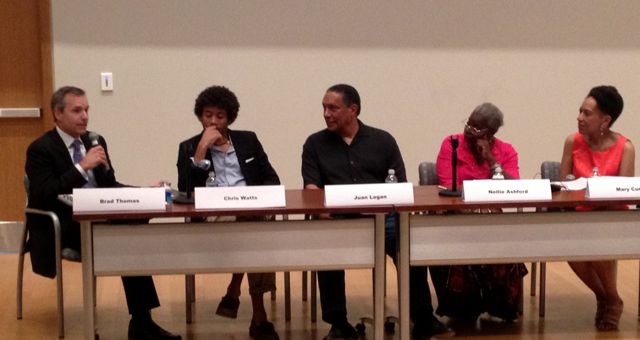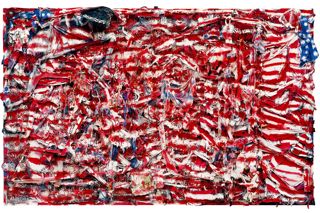
Hard truths: debating the art categories primitive, folk and outsider
In the art world classification is paramount. Art historians, critics and curators spend much of their time seeking to contextualize art — to define art and subsequently artists by shared characteristics. Hence we have the categorization of art by time period, geographical region and personal style; and we use terms like primitive, minimalist, classical, self-taught and high art. But how do these terms impact an artist and his or her work? When do categories like primitive, outsider and folk devalue the art more than they define it?
Furthermore, why are some works valued more than others and who decides?
Hard Truths: African American Art in the Mainstream Art World panel at the Mint Museum Uptown. From left to right: Brad Thomas, Chris Watts, Juan Logan, Nellie Ashford and Mary Curtis.
These questions and more were avidly discussed this past Tuesday night at the Mint Museum’s panel discussion: “Hard Truths: African American Art in the Mainstream Art World.” Panelists Brad Thomas, curator of Contemporary Art at the Mint, Juan Logan, artist and UNC Chapel Hill professor, Nellie Ashford, self-proclaimed folk artist, and Chris Watts, mixed-media artist, explored these questions with the help of moderator Mary Curtis. The panel discussion arose from the current Mint Museum (a Knight Arts grantee) exhibition “Hard Truths: the Art of Thornton Dial,” on view at the uptown location until September 30th.
“Hard Truths” presents a major survey of the art of Thornton Dial, displaying over thirty of his large scale paintings, sculptures and wall assemblages. Dial’s work tackles the “hard truths” of contemporary society, exploring the failures of capitalism, the abuse to the environment, the War in Iraq, the tragedy of Hurricane Katrina and the plight of the rural poor. A working class man raised in the farm fields of Alabama, Dial has not always received such recognition from the art world. In fact, Dial’s work has been called outsider art and he has been criticized for his lack of education. A “60 Minutes” segment in the 1990s even questioned his ability to produce such complex art.
“Don’t Matter How Raggly the Flag, It Still Got To Tie Us Together,” Thornton Dial (American, b. 1928), 2003. Collection of the Indianapolis Museum of Art. Photo by Stephen Pitkin, Pitkin Studio; courtesy of the Mint Museum
Since this panel discussion, I have been thinking a lot about categories in art — those terms: primitive, folk, outsider. Why do we even use them? My background in history and a smattering of anthropology courses in college point me in the direction of human nature and our need to categorize the world around us as a means of understanding. Semiotics urges me to see these categories as symbols used to communicate meaning. Consequently, these categories help us understand art and help us talk about it.
Yet, the categories are problematic. They have the tendency to label an artist in a restrictive manner. Juan Logan pointed out when you label something as African American Art you generate expectations that create stereotypes and often limit the artist. Chris Watts added, “I want to be an artist, not a black artist.” The label “African-American artist” tends to suggest certain shared experiences and certain stylistic elements, but the black experience is so varied this label seems largely useless. Think about the contrast between the works of Jacob Lawrence and Thornton Dial.
Also these categories are often about who and what they exclude as much as who and what they include. Calling Dial’s art “outsider” not only labels him and his work, but it also establishes what is inside or mainstream. For these categories to have meaning they depend on comparison with what they are not. It is important to remember then that labels like primitive, folk, self-taught and high art are constructs, and constructs with power. Finally, we must contemplate who or what creates these categories. In other words who has the power to decide?
Postmodernism has encouraged much of this self-reflective examining and critique along with an effort to blur the boundaries between high and low art — insider and outsider. But the canon of art still thrives and even with revisions artists are constantly labeled and consequently found in the mainstream or outside of it. Thus, it is vital to question the categories that help define this canon.
Mint Museum Uptown: 500 South Tryon St., Charlotte; 704-337-2000; www.mintmuseum.org. Open Tues., 10 a.m. – 9 p.m.; Wed. – Sat., 10 a.m. – 6 p.m.; and Sun., 1 – 5 p.m. Admission: adults, $10; students/seniors, $8; children (ages 5-17), $5.
Recent Content
-
Artsarticle ·
-
Artsarticle ·
-
Artsarticle ·


